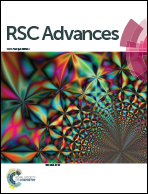Photocurrent responsive films prepared from a nickel-dithiolate compound with directly bonded pyridyl groups†
Abstract
Because the pyridyl group can act as a proton acceptor and a coordination biting unit, electrodes with films of dithiolene complex [n-Bu4N][Ni(4-pedt)2] (1) (4-pedt = 1-(pyridine-4-yl) ethylene-1,2-dithiolate) are prepared to investigate the photocurrent response behaviours of a metal dithiolene compound upon protonation and transition metal coordination. The morphologies of film 1 are characterized by SEM analysis. Photoelectrochemical measurements are carried out with the electrodes of film 1. The results are as follows: (1) the stronger the medium acidity is, the weaker the photocurrent becomes. (2) Photocurrent intensities of Mn(II), Co(II) and Zn(II) treated film 1 are increased in comparison with that of the original film 1 due to the polymeric coordination. (3) When film 1 is treated by Fe(III) ions, it is oxidized to a neutral [Ni(4-pedt)2] film that shows weaker photocurrent response. In addition, a new ionic pair compound MV[Ni(4-pedt)2]2 (2) (MV2+ = methylviologen dication) synthesized by cation exchange shows good photocurrent response properties due to the improvement of electron transfer.


 Please wait while we load your content...
Please wait while we load your content...